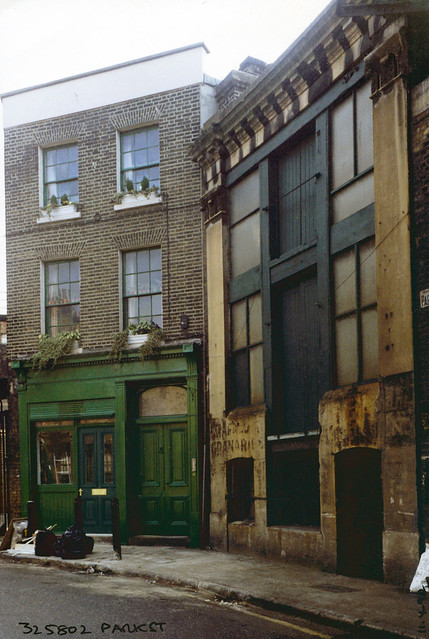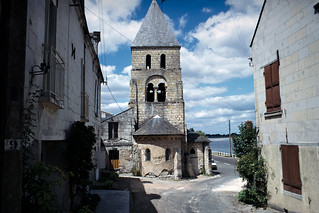I recently added these pictures (and many others) to my Flickr album TQ32 – London Cross-section.
‘Enter In To His Gates With Thanksgiving‘, the sentiment over a church door in Camberwell had two missing letters. It perhaps wasn’t surprising that the door was firmly closed and the gate locked, as I took this picture on a Friday, May 5th 1989. Nothing much special happened that day, but the previous day had been the 10th anniversary of Margaret Thatcher becoming prime minister, whose policies had a great effect on my photography, causing much of the dereliction and empty factories I was recording.
I was still a full-time teacher, but at a sixth-form and community college which then offered a wide range of evening as well as daytime courses. As a union rep I’d won a local agreement on timetabling which limited the number of sessions within which staff could be required to work, as well as national agreements to the number of contact hours. For me that meant my teaching finished at noon, and if I rushed to the station I could be in London taking pictures around an hour later.
I photographed this cafe on several occasions from 1986 to 1992, and though it never looked very open, I think it must still have been in business in the earlier years. In 1991, the street number 108 is painted large, and this was 108 Great Guildford Street, in a little tangle of streets on the edge of Southwark Bridge Road. It was once the Fox and Hounds public house, re-built in 1884 – and according to ‘Pubwiki’, its address over the years has over the years before its current one variously been ‘Little Bandy Leg Walk’, 118 Southwark Bridge Rd and 19 Little Guildford Street.
The building is still there, but the ground floor frontage is much changed. As well as these colour details I find photographed the entire building from across the street in 1992 (and possibly in earlier years.) I think few of the buildings which can be seen reflected in its windows have gone.
Walter Henry Wilcox established his company in 1876-8 selling engineering supplies and lubricating oils and moved from Uppper Thames St across the river to 36 Southwark St in 1880, and first advertised his wire-bound hose, the first of its type in 1888. The wholly-owned subsidiary, the Jones-Willcox Patent Wire Bound Hose Co, was set up in 1897 and was in business on Bankside until 1976 when it moved to Peacock Street. Their Bankside works was demolished around 1986 for the building of the replica Globe Theatre.
Grace’s Guide has condiserable information about the company, including reproductions of many advertisements and a long quotation about the widespread use “thoughout the Empire” of these hoses for petrol and other oils “constructed in an extensive Factory … from specially prepared canvas”. Their hoses contained no rubber which petrol and oils rapidly destroy. https://www.gracesguide.co.uk/1930_Industrial_Britain:_W._H._Willcox_and_Co
“… and he ascended into heaven” says the text at the bottom of this mural, the words I think coming from the head to their left. It may well have been a representation of the priest of St Hugh’s Church, part of a settlement founded in 1885 by former pupils of Charterhouse School to bring education and enlightenment to the deprived communities of Bermondsey and built in 1896. Probably the other figures represented local residents. The mural was I think on the tall wall of the building, part of the settlement premises that then stood on the corner of Porlock St and Crosby Row.
This later became known as the ‘Rainbow Building’ from a later mural on it, a rather primitive representation of a mis-coloured rainbow on a bed of grass with two trees and in the blue sky above a large yellow sun and a larger crude representation of the earth, presumably based on a child’s painting.
Church and ‘Rainbow Building’ were demolished in 2011 and replaced by flats with a new St Hugh’s Church in the basement which opened in 2013.
This corner of Park St next to the railway bridge is still entirely recognisable. This image shows some of the problems of reproducing from a poor quality enprint and at some point I will try to find the negative to make a clearer image. But its defects give it a particular patina.
Painted signs, faded, label 15 Park St as a Granary, and it was apparently in use around 1900 for agricultural produce from Kent farms. There is more largely illegible signage around the right hand door. Some time after I made this picture the carefully faded text ‘PEROT EXPORTATEUR’ was painted over the doorway – presumably for some film – and Banksy and other graffitists later added contributions, including the text ‘BANKSY WOULD BE NOBODY WITHOUT BLEU LE RAT’ to the right-hand side.
Among the films which this building has appeared is as the gang hideout in Guy Ritchie’s 1998 crime comedy film ‘Lock Stock And Two Smoking Barrels’. The street also puts in an appearance in quite a few other films, including Howards End, 102 Dalmations, Keep the Aspidistra Flying, Entrapment…
All photographs on this and my other sites, unless otherwise stated, are taken by and copyright of Peter Marshall, and are available for reproduction or can be bought as prints.















